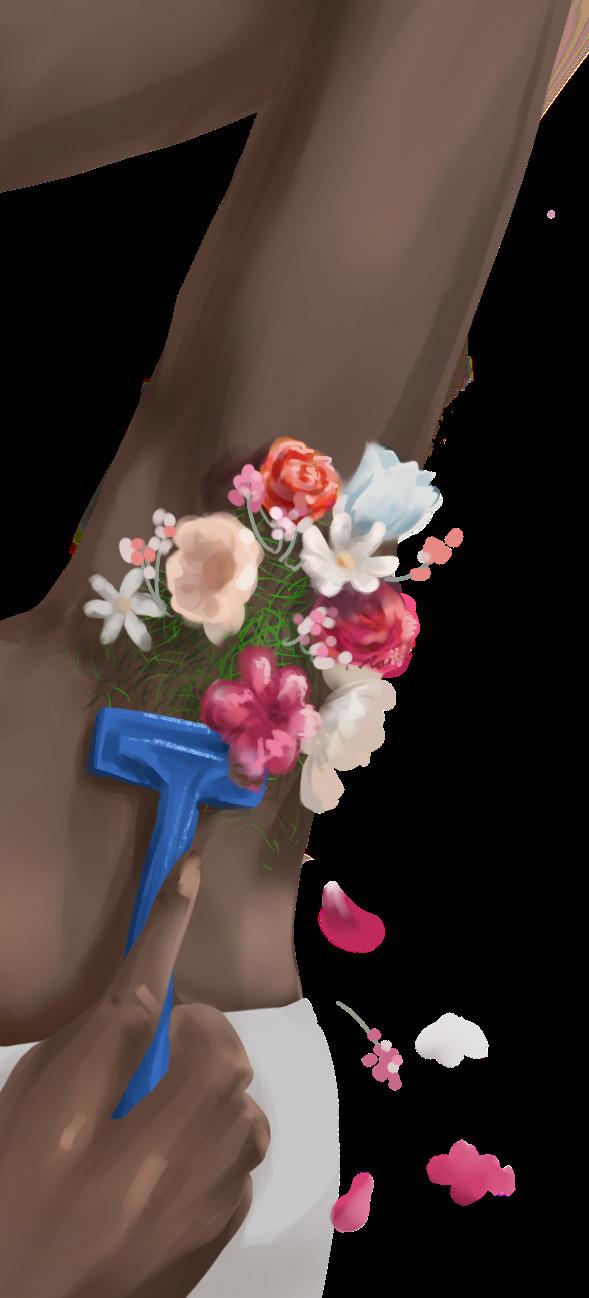
5 minute read
Column: Letting it Grow


Advertisement
LETTING LETTING IT GROW IT GROW
A journey of accepting one’s body hair and embracing their femininity as it is
TANVEE SAI sports editor
When talking about issues that female identifying people face, body hair may not be the first thing that comes to mind. But the stigma surrounding body hair is more prevalent than expected. Most male identifiers get to live with their body hair and embrace it, while female identifiers have to face constant shame for having that same feature. In eighth grade, I noticed that all my female identifying friends were talking about shaving, that all the models on Instagram had shaved legs and armpits, and that my hairy legs stuck out. I became more conscious of my body hair when I went to swim practice and looked down at my legs every day, feeling uglier and uglier. I wallowed in self disgust and felt the need to cover up my legs and armpits every time they were exposed. When our high school promotion rolled around, I begged my mom to let me shave. I had found a dress to wear, bought shoes, and learned how to straighten my hair. All that was left was to get rid of the hair on my body, and I would be pretty. My mom took me to a waxing salon, and as my hair was getting ripped off my body, all I could think about was how pretty I would look after it was over. I kept reminding myself that there was no beauty without pain. My mom left the room to pay, and as I stood up, I looked at my smooth, hairless legs. I saw every mole, every birthmark on my legs, and on the drive home, I rubbed my fingers against my soft, smooth skin.
I went to my promotion ceremony feeling like a woman. I could finally compare to all the beautiful, hairless models I saw all over my feed. Going into high school, I continued waxing my legs. When the first choir concert rolled around, I learned how to use hair removal cream for my armpits. I constantly felt disgusted about my body hair and felt the urge to remove it the
GUST AND FELT THE NEED
TO COVER UP MY LEGS AND
ARMPITS EVERY TIME THEY
WERE EXPOSED.”
TANVEE SAI
minute it regrew.
Then, quarantine happened. I watched as my leg hair grew to lengths it hadn’t been in years and had no urge to hide it or get rid of it. All the waxing salons closed, and because no one was looking at it, I felt no feelings toward my body hair.
Eventually, I decided to join the water polo team and went out for conditioning in October, even though I had not been in my swimsuit since I quit swimming. My mom had recently learned how to wax at home and offered to wax my legs. Afraid of my insecurities, I agreed.
After a few months of conditioning, we went back into lockdown. I started to explore feminism and the body positivity movement, and I learned what it meant to embrace your body and truly love yourself for who you are. Through that, I gradually became comfortable with all of the other self-confidence issues I had with my body, but my feelings toward my body hair remained ambiguous.
Weeks before returning to waterpolo, my mom asked me if I wanted to wax my legs, and I decided not to. I wanted to see how I would feel with my body hair exposed in public; whether I would feel empowered or embarrassed.
After getting comfortable in the pool, I started noticing that my other teammates also had body hair. Unlike in middle school, no one cared if you were clean-shaven or covered in hair; there was a mutual understanding that it was natural. It was like a switch was flipped in my head. Before, it felt like my

femininity was defined by whether or not I had hair on my body. However, I eventually realized that no one has a say on how much hair I have on my legs or arms. It did not determine who I was as a person, and I could live as myself without feeling like a speck of body hair is ugly.
Even though women are taught that body hair is unfeminine, I still present myself in the conventional feminine way. I enjoy wearing dresses, putting on makeup, braiding my hair and wearing crop tops.
Although these actions do not belong to femininity, presenting myself in this way is what defines femininity for me. I no longer associate the presence or lack of body hair with my femininity, and I can embrace my hairy legs and armpits without feeling any less like the woman
I am. Today, it has almost been a year since I last removed the hair on my armpits, and I have not waxed my legs – or felt the need to – in months. Even though it was a long journey to undertake, and learning how to fully embrace your body can be challenging, I have found that having representation helps. Seeing my female identifying peers not caring about their unshaved armpits and legs helped me understand that if I do not want to get rid of my body hair, I do not need to. It is important to remember that you are also making the best choice for yourself, so if you do not want to shave your armpits or legs because it is a hassle, do not!

“I REALIZED THAT NO ONE HAS A SAY ON HOW MUCH HAIR I HAVE ON MY LEGS OR ARMS... I COULD LIVE AS MYSELF WITHOUT FEELING LIKE A SPECK OF BODY HAIR IS UGLY. ” TANVEE SAI

TANVEE SAI (they/she)










